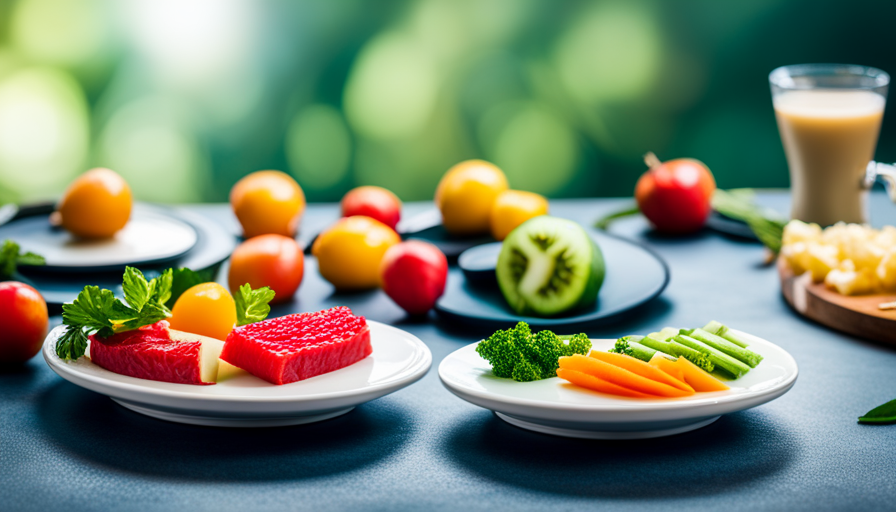Are you tired of feeling bloated and sluggish? Do you want to take control of your health and reduce your risk of high blood pressure and heart disease?
Well, look no further! In this article, we will provide you with practical guidelines for a low sodium diet. By making simple changes to your eating habits, such as eliminating salty foods and reading ingredient labels, you can significantly reduce your sodium intake and start feeling your best.
So, let’s dive in and discover how you can take charge of your health!
Key Takeaways
- Sodium consumption should be reduced to lower the risk of health problems.
- High sodium foods should be eliminated from the diet.
- Salt used in cooking should be reduced.
- Alternative seasonings like spices, herbs, lemon, garlic, ginger, vinegar, and pepper should be used to add flavor to foods.
Understanding Sodium Consumption
You should be aware that the main source of sodium is table salt. The average American consumes five or more teaspoons of salt daily, which is concerning because the body only needs 1/4 teaspoon of salt per day to function properly.
However, sodium is not only found in table salt; it is also added during food processing and preparation. This means that sodium can be hidden in canned, processed, and convenience foods.
To reduce your sodium intake, it is important to eliminate salty foods from your diet and reduce the amount of salt used in cooking. Look for low sodium alternatives and season your foods with spices, herbs, lemon, garlic, ginger, vinegar, and pepper instead.
Remember to read ingredient labels to identify high sodium foods and make informed choices.
Reducing Sodium Intake in Cooking
Start by using less salt in your cooking to reduce your sodium intake. Here are four easy ways to cut back on salt and still enjoy flavorful meals:
-
Experiment with herbs and spices: Add a punch of flavor to your dishes by using herbs like thyme, rosemary, and basil, or spices such as cumin, turmeric, and paprika. These will enhance the taste without relying on salt.
-
Squeeze some lemon: Brighten up your meals by squeezing fresh lemon juice over your dishes. The acidity will add a tangy flavor, reducing the need for salt.
-
Get creative with garlic and ginger: Use minced garlic or grated ginger to add depth and complexity to your recipes. These ingredients bring a burst of flavor that can replace the salt.
-
Try vinegar and pepper: Enhance the taste of your dishes with a splash of vinegar, like balsamic or apple cider vinegar, and a sprinkle of black or white pepper. These will add a zing to your meals without the extra sodium.
Identifying Hidden Sodium in Foods
Identify high sodium foods by reading ingredient labels and being aware of hidden sources of sodium in processed and convenience foods. It’s important to be mindful of the sodium content in the foods you consume, as excessive sodium intake can lead to health problems like high blood pressure. By reading ingredient labels, you can easily identify foods that are high in sodium. Additionally, be aware of hidden sources of sodium in processed and convenience foods, as sodium is often added during their preparation. To help you make better choices, here is a table that showcases some common high sodium foods and their sodium content:
| Food | Sodium Content (mg) |
|---|---|
| Canned Soup | 800 |
| Frozen Pizza | 1200 |
| Potato Chips | 170 |
| Deli Meats | 500 |
Exploring Low Sodium Food Options
Check out the wide range of low sodium food options available to help you reduce your sodium intake.
-
Fresh fruits and vegetables: These are naturally low in sodium and high in nutrients. Incorporate a variety of colorful produce into your meals and snacks.
-
Lean proteins: Opt for lean cuts of meat, poultry, and fish. Avoid processed meats, which are often high in sodium. Try plant-based protein sources like beans, lentils, and tofu.
-
Whole grains: Choose whole grain bread, pasta, and rice, which are lower in sodium compared to their refined counterparts.
-
Low sodium condiments and seasonings: Swap out high sodium condiments like soy sauce and ketchup for low sodium alternatives. Season your food with herbs, spices, and citrus juices for added flavor.
Flavoring Foods Without Salt
Enhance the taste of your meals without using salt by incorporating flavorful herbs, spices, and citrus juices.
These ingredients can add depth and complexity to your dishes, making them satisfying and delicious. Experiment with different combinations to find your favorite flavor profiles.
Use herbs like basil, rosemary, and thyme to add freshness and fragrance. Spices such as cumin, paprika, and turmeric can provide warmth and richness. Citrus juices like lemon, lime, and orange can bring a tangy and vibrant element to your meals.
Don’t be afraid to get creative in the kitchen and try new combinations. By using these alternatives to salt, you can still enjoy flavorful meals while reducing your sodium intake.
Reading Ingredient Labels for High Sodium Foods
When you read ingredient labels, make sure to look for hidden sources of sodium in canned, processed, and convenience foods. Here are four things to keep in mind as you search for high sodium foods:
-
Sodium is often added during the processing and preparation of food, so even seemingly healthy options can be high in sodium.
-
Canned foods, such as soups and vegetables, are notorious for their high sodium content. Opt for low sodium or no salt added options whenever possible.
-
Processed meats, like deli meats and sausages, can be loaded with sodium. Look for lower sodium alternatives or limit your intake.
-
Convenience foods, such as frozen meals and snack foods, can be packed with sodium to enhance flavor and extend shelf life. Read labels carefully and choose lower sodium options.

